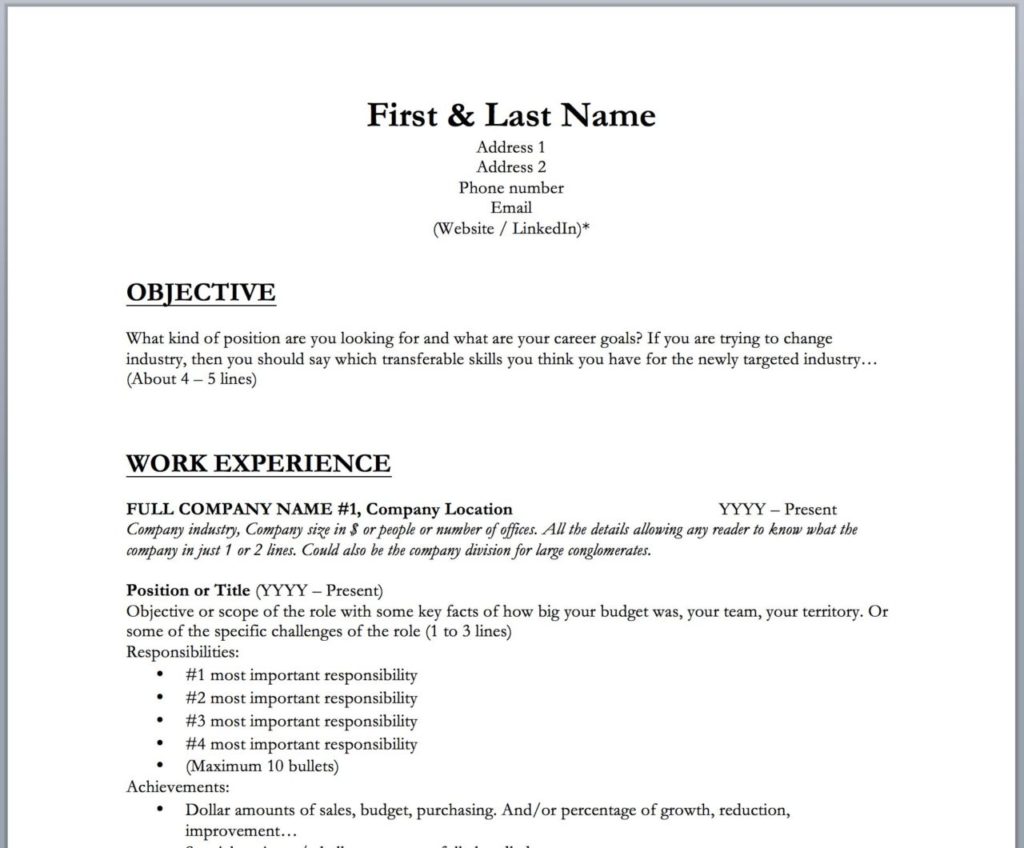How to write a great resume for a job
10 tips for writing a good resume!
Resume writing tips and articles always leave out the most important. It takes only 5 seconds for your resume and your job application to be rejected! And you have only 1 chance to make a good first impression. Therefore, it is key that you know what makes your resume stand out right away. And it is not the layout…
Also we usually advise against using professional Resume Writing Services as they rarely are the ones selecting the resumes in the end. And if you are looking for a corporate job, you should be able to write it yourself!
We have created a video summarizing all our professional resume writing tips:
Also, at the bottom of this post, there is a link to download our Professional Resume Template.
Now let’s get started on how to write a good resume!
Layout
It is our strong professional opinion that resumes should look standard and plain. Even if you are a Graphic Designer, in which case you can be creative with your portfolio. Trying to add many colors and graphic design elements is a common resume mistake. It comes out as a distraction for the hiring managers, who usually know what they are looking for and where to find it.
Structure
While having a good structure is not sufficient, it is however necessary to show how professional you are and to highlight all the important details of your profile.
- Contact details
- Objective
- Work experience
- Education
- Computer and Language skills
We have intentionally left out the “professional summary” section as we believe it has more “cons” than “pros”.
Contact details
Have a professional email address. Not teenage-looking… And ideally not @aol.com as everyone is wondering how it is still working….
Get a local phone number, if you are abroad but plan on relocating if you land a job…
Just below your contact details is the perfect place to display that you are legally authorized to work in the country. If your entire experience is abroad, potential employers will legitimately be concerned about your eligibility to work here. And if you have a valid work authorization, you absolutely should show it!
Objective
Skip the professional summary. It is usually a hard-to-read summary of your resume. And your resume is already a summary of your career. To get a quick understanding of your profile, we usually scroll very quickly through your resume to catch employer names, job titles, industries, dates and location. This is much quicker and provides so much more details.
Save some space for what really counts!
Instead of a summary, explain what job you are looking for in a short Objective section. Explain your career goals, your transferable skills if you want to change industry, and the job you are currently looking for.
Work Experience or Professional experience
The really big piece!
Employer names
Most important: Are your employer names and job titles very clearly highlighted?
Same thing for your dates of employment and why not job locations?
It should take us literally 5 seconds to get all this. If not, this is the biggest mistake you can make when writing your resume!
Your employer names, regardless of how well known they are, should have a brief 1 or 2 lines description. This company description should give us the industry, the product or services, some idea about the size and anything else relevant. It is absolutely necessary if the company is not very well known, and a good professional best practice to show off how concise and clear you can be introducing a large corporation.
Job titles
We think in many cases, job titles could also benefit from a quick intro on 1 or 2 lines providing some key facts, such as what is the size of your business, what is your territory, how many people you manage, who you are reporting to, who are your clients etc… A quick series of key facts like that goes a long way for us to interpret and dimension your role!
Job description
- Organize your content in bullet points. It is much easier to read and scroll through, than a full text paragraph.
- Don’t list 20 bullet points! It’s too much.
- Prioritize your ideas. Don’t start with your administrative duties if you are in sales. Start with Sales and anything showing you are very sales driven!!
- If you still have too many bullets point, you could split them in 2 sections: JOB DESCRIPTION and ACHIEVEMENTS. It is not very frequent, but we like very much because it helps showing off how structured you are and it helps our reading.
Education
Put your education section before your work experience, only if you are very junior, or, why not, if you have a big Ivy league name to show off. But even if you have Harvard and 5 years of experience, in our opinion, those years of experience should count more.
We usually do not pay too much attention to that section. We just want to see it exists and make sure there is at least a Bachelor degree (because we mostly recruit for corporate jobs).
Overall don’t take too much space here unless, again, you are very junior, in which case you can add some of your most important classes or anything else you want to highlight.
Types of Skills
How to write skills in a resume?
Depending on your field, you may want to split languages and computer skills. But for most non-technical jobs, there are ok together. Overall it doesn’t matter too much as long as they show up at the end of your resume, where there are expected to be. For most job seekers, there are no other skills to write on a resume.
Computer skills is a classic where for most people we expect to see at least Excel, but everyone is just writing the exact same thing. They are proficient… Whatever that means. So if you are good and want to stand out, one very efficient tip we see sometimes, is people adding the advanced functions and features they know, like Vlookup, pivot table or macros. So NOW THAT tells us something! And you DO stand out.
We are now done with the actual content of the resume and this is where it gets very interesting: the most unknown insider tips.
Resume “SEO” and ATS optimization
One thing that executive resume writing services have always wrong is their lack of understanding of how an ATS work. Most well organized companies use an ATS. ATS stands for Applicant Tracking System and those ATSs are basically databases of candidates, that have the ability to receive and manage your applications. But they are not just storing your resume, they are reading your resume, interpreting it and creating or updating your candidate profile. They are actually able to recognize what is your name, your email, who were your employers, your date of employments etc… and filling up automatically your candidate profile with a certain degree of accuracy. It is called parsing, resume parsing!
Then decision makers, use the ATS search engine to locate relevant candidates. If the parsing of your resume hasn’t been done properly, your resume might not be found and whereas a classic well-structured resume should get a parsing accuracy of 90 to 100%, a poorly structured resume or a resume using an improper structure can go down to 0% accuracy. Just invisible…
How can you maximize the parsing accuracy of your resume?
File format.
Word documents tend to perform much better. PDFs however, even though they look modern and professional, tend to confuse resume parsers.
As much as we like PDFs, but it is a safer bet to stick to Word.
The one thing you should avoid at all cost is an image PDF. There are 2 types of PDFs, text-PDFs and image-PDFs. If you save your word, document as a PDF it going to be a text PDF, “readable” by a resume parser. If you create your resume on photoshop because you want it to look different and fancy (DON’T), or if you scan your old damaged paper copy and save them as PDF (DON’T EITHER), they will be image-PDFs, that a parser won’t be able to read at all.
Header and Footer
Contact details in header and footer are also a risk that the parser will not pick that up.
Reduce a little the size of the header and footer if you want, but it is better avoid putting anything else that a page number there.
Table
You might have seen resume templates based on a word table of few rows and columns, so that it guarantees proper alignment of your content before you remove those lines. It might work well for a clean structured layout, but resume parsers hate that. You should avoid tables.
Keyword SEO
Finally, you should consider keyword SEO, Search Engine Optimization. Like for websites wanting to be found on google for certain keywords, if you want your resume to be found for certain keywords too, you need to include them…
How many times have we seen consumer goods professionals not mentioning “consumer goods” once in their resume…?
There are not that many types of keywords we can use to search for candidates in our ATS or linkedin or any resume database: company names, industry descriptions, job titles, maybe territories or languages. You need to make sure your keywords show up somewhere. Employer names will show up, but if you worked in small unknown companies, it doesn’t help. You should consider adding your client names then. This is another very important reason to introduce your employer or job title by a line or 2 of key facts (usually full of important keywords).
If you want to change industry, using the Objective section to add those new keywords, is an efficient tactic.
Professional best practices
File name
Whether it is for your resume or any other documents, the file name should make sense by itself. It looks good and professional, but it also makes it easier for decision makers to find it in their hard drive if they don’t have an ATS.
So includes the words: Resume, your name, ideally the date or the year, so that we can see how current it is. You can also add the title of the job you are looking for. And why not ENG for English, or SP for Spanish or FR for French…
Mailing
Don’t paper mail your resume, or at least don’t only mail it. It is 2018, paper goes to the trash and it hurts the planet. Our office is 100% paperless for example. Of course, we will take a brief look at it, but with the wrong first impression in mind. If you still want to do it, you should absolutely follow the rest of the modern processes of applying online or emailing your resume.
But how to use your great new resume is all other new topic for a future video!
We hope you learnt something in this guide and here is a link to download a resume template we have created that includes all our resume writing tips. You can use it as a framework and modify it at your convenience, as long as you remain plain and simple!



